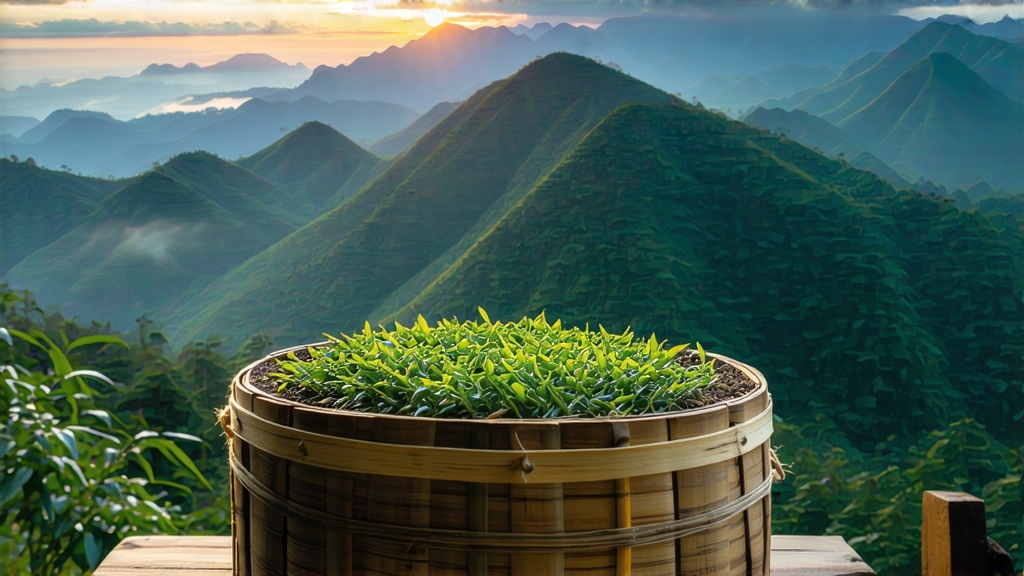
High on Meng Ding Mountain, where Sichuan’s clouds brush the bamboo tops, a tea once reserved for emperors still unfurls its single, down-covered bud each spring. Meng Ding Huang Ya—literally “Yellow Bud from Meng Ding”—is the least-known member of China’s noble yellow-tea family, yet in the Tang dynasty it was carried 1,500 km by relay horse to Chang-an palace so that the Son of Heaven could taste the season before anyone else. Today only 300 mu (20 ha) of the original garden remain, clinging to 1,200 m of granite terraces first terraced by the Buddhist monk Wu Li-zhen in 53 BCE. Those bushes, descendants of seed he planted, are still picked by the grand-children of pickers who served the last Qing court, making every kilo a living manuscript of Chinese tea history.
Yellow tea is not a half-green, half-black curiosity; it is a deliberate micro-fermentation created by “sealed yellowing” (men huang). While green tea chases freshness and oxidation is arrested within minutes, yellow tea is wrapped, steamed and rested so that a gentle 10–15 % oxidation occurs inside the leaf. The result is a liquor the color of chrysanthemum honey, a bouquet that hovers between orchid and steamed corn, and a finish that coats the tongue like warm custard. Of the three historic yellow teas—Jun Shan Yin Zhen, Huo Shan Huang Ya, and Meng Ding Huang Ya—the last is the most elusive, produced only between Qing Ming and Gu Yu when the bud is still shorter than a knuckle.
Picking begins at dawn when the mountain dew is exactly 0.4 g per bud; any heavier and the leaf will stew during yellowing, any lighter and enzymatic activity stalls. Two-leaf-and-a-bud plucks are rejected—only the unopened spear is taken, laid in shallow bamboo sieves lined with goat-skin paper to prevent bruising. Within thirty minutes the buds reach the village workshop, a cedar-beam hall whose earthen floor has absorbed the aroma of four dynasties. Here the master, always addressed as “shifu” even if she is a woman, performs the five acts of yellow alchemy.
First, sha qing (kill-green) is done in a wok tilted to 25°, its surface brushed with camellia oil so the bud glides rather than scorches. Temperature is held at 140 °C for exactly 90 seconds; the leaf must lose 30 % moisture yet keep its white down. Next comes the signature move: men huang. The hot buds are piled 5 cm deep in linen bags, then slid into a pine box lined with wet cloth. For four hours the box rests above a charcoal brazier whose heat never exceeds 45 °C. During this steamy siesta chlorophyll quietly breaks down, polyphenols oxidise, and the leaf edges turn the colour of antique parchment. The third step is a second, gentler firing—80 °C for three minutes—to fix the newborn aromatics. After cooling on woven rattan, the buds undergo hong bei, a low 60 °C bake that deepens the honey note and reduces moisture to 5 %. Finally the tea is wrapped in yellow silk and left to “sleep” for seven days in a clay jar, allowing residual moisture to migrate outward so the finished leaf crackles like thin caramel.
When you open a tin of authentic Meng Ding Huang Ya the first sensation is visual: needles of greenish-gold that feel cool between the fingers, as if the mountain mist is still locked inside. Inhale deeply and you catch steamed rice, fresh soy bean and a trace of Sichuan pepper orchards blooming two valleys away. Brew it western-style and you will enjoy a pleasant cup; brew it gongfu-style and you meet the tea’s soul. Use a porcelain gaiwan of 120 ml, 4 g of leaf, and water at 85 °C—never hotter, or the down will scald and release tannic bitterness. After a five-second rinse to wake the buds, infuse 15 s, 20 s, 30 s, 45 s, then add ten seconds for each subsequent pour. Watch the buds stand upright, then slowly sink like miniature jade spears. The first liquor is the colour of morning sun on limestone; sip, and a wave of sweet corn washes across the tongue, followed by snap pea, steamed edamame,